It’s a great time to get into motorcycling. Just a few years ago there were only a few small-bore bikes to choose from—and some of them weren’t very compelling—but in recent years the low-buck beginner-bike category has undergone a serious revival. Now there are lots of appealing options to choose from.
Honda’s new CBR300R is just the latest.
Looking to build on the success of the lightweight and easy-to-ride CBR250R, Honda has given the bike a 37cc displacement boost and a comprehensive makeover. While the original 249cc CBR was modeled after the VFR1200F sport tourer, this new 286cc bike adopts the lines of Honda’s CBR500R, CBR600RR, and CBR1000RR sportbikes. As Honda’s Motorcycle Media Coordinator Tony DeFranze put it, “just because you’re new to motorcycle riding doesn’t mean you have to look that way.”
Indeed, the 300R’s twin headlights, sleeker windscreen and mirrors, new muffler, and sharper bodywork link it to the CBR sportbike family in the same way that Kawasaki’s Ninja 300 resembles its big brothers. In fact, the Honda’s appearance compelled every sportbike rider we passed while riding around Torrance and Rancho Palos Verdes, CA, during the bike’s press intro to give us “the wave.” I spent thousands of miles on the street on a CBR250R and never received such consistent recognition. Besides being more appealing on the showroom floor, this new bike is going to garner new riders a lot more acknowledgement on the street. And who wouldn’t like that?
The new bodywork isn’t just for looks, though. A revised seat and narrower side panels make it easier for shorter riders to get both feet flat on the ground. If a 30.7-inch seat height isn’t low enough, you can buy Honda’s accessory saddle that reduces seat height by more than an inch. That makes the CBR300R the most accessible sportbike on the market. And at 357 pounds (claimed, wet), the little Honda is the lightest bike in its class by more than 20 pounds.
In terms of performance, the 300‘s bigger motor yields noticeably stronger low-end and midrange grunt. Drop into first, slip the clutch at idle, and you’re on your way. I found myself short-shifting to fifth or even sixth gear while puttering around town, mainly because the little thumper has enough power on tap to accelerate from as low as 3,000 rpm. Honda says the 37cc bump—accomplished by way of an 8mm increase in stroke—boosts peak output by 17 percent. The last CBR250R we ran on the dyno made 22.3 hp, so it’s likely that this new bike will make somewhere in the neighborhood of 26 hp. That’s still quite a bit down on the 33 hp the twin-cylinder Ninja 300 puts to the rear wheel, but plenty for urban riding, carving canyons, and the occasional freeway run. Honda says that revised fuel mapping allows the 300 to squeeze 71 miles out of every gallon of regular unleaded. And while that seems like a big number, it’s actually 6 mpg down from the claim made for the 250.
Aside from boasting more power and a new look, the CBR300R is the same sweet little machine we’ve grown to love. The clutch is just as light and progressive, the transmission shifts easily, and the throttle response is still super smooth. The riding position is moderately sporty but still comfortable thanks to above-the-triple-clamp clip ons, and the bike feels wonderfully light, compact, and maneuverable. Handling is excellent, with quick responses to a light touch at the bar.
Honda improved the CBR300R considerably, yet the price is still an affordable $4,399, just $200 more than the outgoing CBR250R. By comparison, Kawasaki’s Ninja 300, which is likely to be the CBR’s fiercest competition, rings in at $4,999. The CBR300R ABS—which has independent servos front and rear—goes for $4,949, while the Ninja 300 ABS costs $5,299.
No question, the extra torque from the larger engine makes the CBR300R a better all-around bike than the 250. So it’s better for beginners, more exciting for experienced riders, all without losing the 250’s sweet, light feel. Good times for the small-displacement class, for sure.











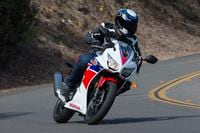


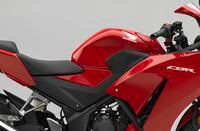
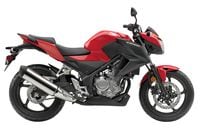
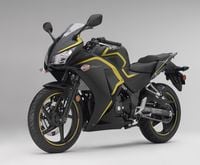
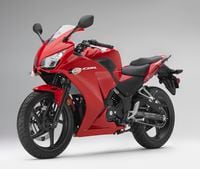


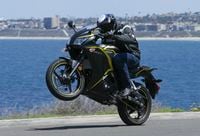
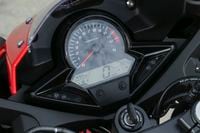
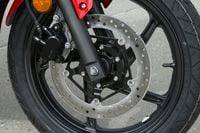
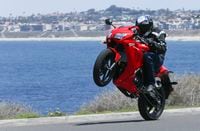
/cloudfront-us-east-1.images.arcpublishing.com/octane/2WF3SCE3NFBQXLDNJM7KMXA45E.jpg)
/cloudfront-us-east-1.images.arcpublishing.com/octane/G4MG6OUCJNBSHIS2MVVOTPX65E.jpg)
/cloudfront-us-east-1.images.arcpublishing.com/octane/IIGGWFOTOJGB7DB6DGBXCCMTDY.jpg)
/cloudfront-us-east-1.images.arcpublishing.com/octane/QSTCM6AVEZA5JJBUXNIQ3DSOF4.jpg)
/cloudfront-us-east-1.images.arcpublishing.com/octane/U4I7G625B5DMLF2DVIJDFZVV6M.jpg)
/cloudfront-us-east-1.images.arcpublishing.com/octane/B6XD6LS6IVCQPIU6HXDJSM3FHY.jpg)
/cloudfront-us-east-1.images.arcpublishing.com/octane/ICL63FEDDRDTTMINYICCEYGMDA.jpg)
/cloudfront-us-east-1.images.arcpublishing.com/octane/FCGZHQXRBZFLBAPC5SDIQLVF4I.jpg)
/cloudfront-us-east-1.images.arcpublishing.com/octane/WNOB6LDOIFFHJKPSVIWDYUGOPM.jpg)

/cloudfront-us-east-1.images.arcpublishing.com/octane/X33NU3E525ECRHXLNUJN2FTRKI.jpg)
/cloudfront-us-east-1.images.arcpublishing.com/octane/6KKT5NNL2JAVBOXMZYS5ZO76YA.jpg)
/cloudfront-us-east-1.images.arcpublishing.com/octane/J5RKG5O455GMPGQRF2OG6LRT7A.jpg)
/cloudfront-us-east-1.images.arcpublishing.com/octane/GX2CIZKQVRH2TATDM26KFG2DAE.jpg)
/cloudfront-us-east-1.images.arcpublishing.com/octane/ZWIDYSAKQZHD5BHREMQILXJCGM.jpg)
/cloudfront-us-east-1.images.arcpublishing.com/octane/CYUHJZCTSJCH3MRAQEIKXK7SCQ.jpg)
/cloudfront-us-east-1.images.arcpublishing.com/octane/LKOFINY56FCXJCANJ5M7ZDQUBY.jpg)
/cloudfront-us-east-1.images.arcpublishing.com/octane/4NBPDACMWJH63JQYJVK3QRBDZI.jpg)
/cloudfront-us-east-1.images.arcpublishing.com/octane/KKHQHRR3FJGX7H2IPU6RALMWG4.jpg)

/cloudfront-us-east-1.images.arcpublishing.com/octane/5IOFS5JAE5FOXMNA23ZRAVVYUU.jpg)
/cloudfront-us-east-1.images.arcpublishing.com/octane/CGXQ3O2VVJF7PGTYR3QICTLDLM.jpg)
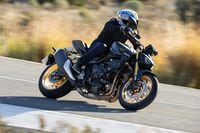
/cloudfront-us-east-1.images.arcpublishing.com/octane/OQVCJOABCFC5NBEF2KIGRCV3XA.jpg)